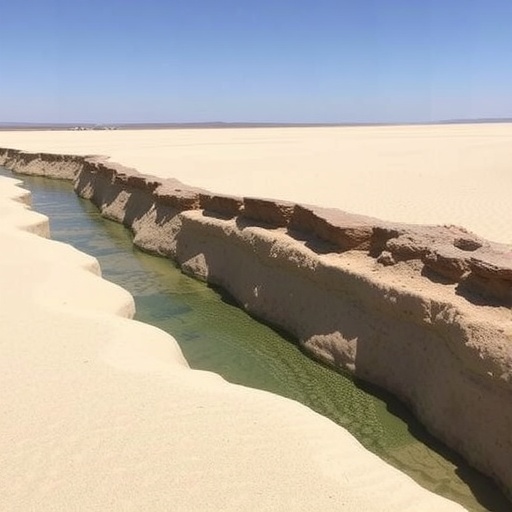In a groundbreaking study soon to be published in “Environmental Monitoring and Assessment,” researchers have employed a multi-residue approach to analyze organic compounds found in sedimentary cores from coastal environments, specifically focusing on the subtropical estuary of Sepetiba Bay in the southwestern Atlantic. The research unveils critical insights into the historical and contemporary pollution dynamics of this important marine ecosystem, underpinning the importance of sedimentary studies in environmental monitoring and restoration efforts.
The research conducted by Gripp, Ceccopieri, da Silva Carreira, and their colleagues emphasizes the diverse array of organic compounds present in sediment layers, incorporating a robust methodological framework that combines both chemical analysis and ecological assessments. By examining sedimentary cores, scientists can reconstruct a timeline of environmental changes, assessing the influence of anthropogenic activities on coastal water quality over time.
Understanding the layers of sediments allows researchers to piece together the history of pollution in Sepetiba Bay, a vital habitat heavily influenced by urban development, industrial discharges, and agricultural runoff. The study used advanced techniques to isolate and identify various organic pollutants, including hydrocarbons, pesticides, and industrial chemicals that have been accumulating in the sediment over several decades.
The implications of this research are profound, as the findings suggest that many of these pollutants can persist in the environment and may have long-term ecological consequences. Persistent organic pollutants (POPs), which are known for their deleterious effects on both human health and marine life, were one of the focal points of this study. By tracing their presence in sedimentary cores, the researchers could begin to understand their fate and transport within the estuarine system.
Moreover, the research suggests a troubling trend: increasing levels of certain toxic compounds in more recent sediment layers. This raises alarms about ongoing pollution sources and highlights the urgent need for pollution mitigation strategies. As urbanization and industrial activities continue to expand around Sepetiba Bay, the risk of contamination only grows, threatening local biodiversity and the sustainability of fisheries that rely on clean water resources.
The study also employed robust statistical analyses to correlate organic compound concentrations with historical data on land use changes and industrial developments in the surrounding areas. This multidisciplinary approach provides a more comprehensive view of the environmental impacts of various human activities, enhancing our understanding of the relationship between socio-economic factors and ecological health.
Another critical aspect of this research is its potential application in informing policy decisions. By presenting a detailed record of pollution events extracted from sedimentary layers, the findings can support environmental regulatory frameworks and guide restoration efforts. Policymakers can utilize this information to prioritize areas that may require immediate action or more stringent environmental protections.
Furthermore, the research highlights the importance of ongoing monitoring and assessment in estuarine environments and coastal areas globally. With climate change and anthropogenic pressures intensifying, understanding sediment dynamics offers vital clues to managing these ecosystems effectively. The methodologies developed in this study could pave the way for similar research in other coastal regions, enhancing our collective understanding of pollutant behavior in various marine settings.
As environmental challenges evolve, employing innovative approaches such as the multi-residue analysis in sediment cores becomes crucial not only for scientific inquiry but also for practical environmental management. By utilizing these detailed sediment profiles, researchers can provide deeper insights into the long-term consequences of pollution, thereby aiding in restoring balance within affected ecosystems.
In conclusion, Gripp et al.’s research serves as a critical reminder of the lasting impacts that human activity can have on coastal environments. The findings underscore the need for immediate and sustained efforts to mitigate pollution and protect these essential ecosystems. As we move forward, embracing such comprehensive and innovative scientific methodologies will be key in addressing the pressing environmental issues of our time.
The study outlines a profound narrative about the health of Sepetiba Bay and presents a cautionary tale that resonates globally. As coastal regions face numerous threats—from urban expansion to climate-induced changes—the insights gained from sedimentary core analyses offer valuable lessons in our collective pursuit of sustainable development and environmental stewardship.
While findings from Sepetiba Bay are region-specific, the broader implications of this research can inspire similar examinations worldwide. By understanding the historical context of pollution through sediment records, the global scientific community can adopt a proactive stance in assessing and mitigating environmental risk.
This research not only enriches the field of environmental monitoring but also calls upon scientists, policymakers, and the public to recognize and act upon the vital connections between human activity and ecological health. Advances in sedimentary core analysis may very well illuminate pathways toward a cleaner, more sustainable future for coastal ecosystems everywhere.
Subject of Research: Sedimentary cores in coastal environments and their organic compound analysis.
Article Title: Extrapolating findings from sedimentary cores in coastal environments – a multi-residue approach to organic compounds in a subtropical estuary (Sepetiba Bay, SW Atlantic).
Article References: Gripp, L., Ceccopieri, M., da Silva Carreira, R. et al. Extrapolating findings from sedimentary cores in coastal environments – a multi-residue approach to organic compounds in a subtropical estuary (Sepetiba Bay, SW Atlantic). Environmental Monitoring and Assessment, 197, 1317 (2025). https://doi.org/10.1007/s10661-025-14710-2
Image Credits: AI Generated
DOI: https://doi.org/10.1007/s10661-025-14710-2
Keywords: Sediment, Organic Compounds, Pollution, Coastal Environment, Sepetiba Bay, Environmental Monitoring, Coastal Management, Persistent Organic Pollutants.




